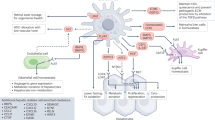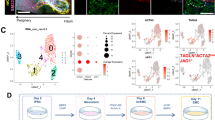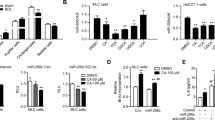Abstract
Background
The selective bile duct ligation (sBDL) model has been proposed to study fibrosis progression in segmental cholestasis, replicating histopathological features of biliary obstruction in both liver parenchyma with biliary obstruction (BO) and without biliary obstruction (WBO). However, the molecular mechanisms driving fibrogenesis in WBO parenchyma remain unclear. This study aimed to characterize gene expression and histological alterations in fibrogenesis using the sBDL model.
Methods
Liver samples were collected at 1, 4, and 8 weeks post-surgery from both BO and WBO parenchyma, undergoing histological, immunohistochemical, biochemical, and molecular analyses.
Results
Differentially expressed genes (DEGs) were associated to inflammatory response, extracellular matrix production, angiogenesis, and negative regulation of peptidase activity. Histologically, ductular proliferation, inflammatory infiltration, and collagen deposition were observed in both BO and WBO parenchyma, with more pronounced inflammation and hepatocellular degeneration in BO. BO parenchyma showed more pathways related to disease progression. In contrast, pathways related to cellular senescence and the PI3K-Akt signaling, suggesting suppression of apoptosis and cell proliferation.
Conclusion
The sBDL model mirrors key aspects of human biliary fibrosis, offering novel molecular insights into fibrogenesis in segmental cholestasis and serving as a valuable tool for developing diagnostic and therapeutic strategies.
Impact
-
This study demonstrates that hepatic fibrogenesis extends beyond regions directly affected by biliary obstruction, involving non-obstructed liver parenchyma. Using the selective bile duct ligation (sBDL) model, we identified key molecular pathways associated with fibrogenesis in segmental cholestasis. Our findings provides new insights into the mechanisms of cholestatic fibrosis and highlighting the sBDL model as a valuable preclinical tool. These results may inform the development of novel therapeutic strategies for treating biliary fibrosis.
This is a preview of subscription content, access via your institution
Access options
Subscribe to this journal
Receive 14 print issues and online access
$259.00 per year
only $18.50 per issue
Buy this article
- Purchase on SpringerLink
- Instant access to full article PDF
Prices may be subject to local taxes which are calculated during checkout







Similar content being viewed by others
Data availability
All data generated or analyzed during this study are included in this article. The datasets used during the current study are available from the corresponding author on reasonable request.
References
Haafiz, A. B. Liver fibrosis in biliary atresia. Expert Rev. Gastroenterol. Hepatol. 4, 335–343 (2010).
Yeo, D., Perini, M. V., Muralidharan, V. & Christophi, C. Focal intrahepatic strictures: a review of diagnosis and management. HPB 14, 425–434 (2012).
Kumagi, T. & Heathcote, E. J. Primary biliary cirrhosis. Orphanet J. Rare Dis. 3, 1 (2008).
Lazaridis, K. N. & LaRusso, N. F. The Cholangiopathies. Mayo Clin. Proc. 90, 791–800 (2015).
Kriegermeier, A. & Green, R. Pediatric cholestatic liver disease: Review of bile acid metabolism and discussion of current and emerging therapies. Front. Med. 7, 149 (2020).
Tam, P. K. H., Yiu, R. S., Lendahl, U. & Andersson, E. R. Cholangiopathies—towards a molecular understanding. EBioMedicine 35, 381–393 (2018).
Qian, Y., Ben, Liu, C. L., Lo, C. M. & Fan, S. T. Risk factors for biliary complications after liver transplantation. Arch. Surg. 139, 1101 (2004).
Boeva, I., Karagyozov, P. I. & Tishkov, I. Post-liver transplant biliary complications: current knowledge and therapeutic advances. World J. Hepatol. 13, 66–79 (2021).
Shneider, B. L. et al. Total serum bilirubin within 3 months of hepatoportoenterostomy predicts short-term outcomes in biliary atresia. J. Pediatr. 170, 211–217.e2 (2016).
Andrade, W. et al. Current management of biliary atresia based on 35 years of experience at a single center. Clinics 73, e289 (2018).
Gibelli, N. E. M., Tannuri, U., De Mello, E. S. & Rodrigues, C. J. Bile duct ligation in neonatal rats: is it a valid experimental model for biliary atresia studies?. Pediatr. Transplant. 13, 81–87 (2009).
de Castro Andrade, W. et al. Effects of the administration of pentoxifylline and prednisolone on the evolution of portal fibrogenesis secondary to biliary obstruction in growing animals: immunohistochemical analysis of the expression of TGF- β and VEGF. Clinics 67, 1455–1461 (2012).
Tannuri, A. C. A. et al. Effects of selective bile duct ligation on liver parenchyma in young animals: histologic and molecular evaluations. J. Pediatr. Surg. 47, 513–522 (2012).
Bergman, I. & Loxley, R. Two improved and simplified methods for the spectrophotometric determination of hydroxyproline. Anal. Chem. 35, 1961–1965 (1963).
Namimatsu, S. Reversing the effects of formalin fixation with citraconic anhydride and heat: a universal antigen retrieval method. J. Histochem. Cytochem. 53, 3–11 (2005).
Alelú-Paz, R. et al. A new antigen retrieval technique for human brain tissue. PLoS ONE 3, e3378 (2008).
Leong, A. S.-Y. & Haffajee, Z. Citraconic anhydride: a new antigen retrieval solution. Pathology 42, 77–81 (2010).
Kuleshov, M. V. et al. Enrichr: a comprehensive gene set enrichment analysis web server 2016 update. Nucleic Acids Res. 44, W90–W97 (2016).
Prado, I. B., dos Santos, M. H. H., Lopasso, F. P., Iriya, K. & Laudanna, A. A. Cholestasis in a murine experimental model: lesions include hepatocyte ischemic necrosis. Rev. Hosp. Clin. Fac. Med. Sao Paulo 58, 27–32 (2003).
Bebiashvili, I. S. et al. Features of ductular reaction in rats with extrahepatic cholestasis. Bull. Exp. Biol. Med. 172, 770–774 (2022).
Ljubuncic, P. Evidence of a systemic phenomenon for oxidative stress in cholestatic liver disease. Gut 47, 710–716 (2000).
Allen, K., Jaeschke, H. & Copple, B. L. Bile acids induce inflammatory genes in hepatocytes. Am. J. Pathol. 178, 175–186 (2011).
Hackett, E. S., Twedt, D. C., Gustafson, D. L. & Schultheiss, P. C. Hepatic disease of horses in the Western United States. J. Equine Vet. Sci. 45, 32–38 (2016).
Manco, R. et al. Reactive cholangiocytes differentiate into proliferative hepatocytes with efficient DNA repair in mice with chronic liver injury. J. Hepatol. 70, 1180–1191 (2019).
Yoo, K.-S., Lim, W. T. & Choi, H. S. Biology of cholangiocytes: from bench to bedside. Gut Liver 10, 687–698 (2016).
Cai, X., Tacke, F., Guillot, A. & Liu, H. Cholangiokines: undervalued modulators in the hepatic microenvironment. Front. Immunol. 14, 1192840 (2023).
Maroni, L. et al. Functional and structural features of cholangiocytes in health and disease. Cell. Mol. Gastroenterol. Hepatol. 1, 368–380 (2015).
Gonçalves, J. O., Tannuri, A. C. A., Coelho, M. C. M., Bendit, I. & Tannuri, U. Dynamic expression of desmin, α-SMA and TGF-β1 during hepatic fibrogenesis induced by selective bile duct ligation in young rats. Braz. J. Med. Biol. Res. 47, 850–857 (2014).
Heinrich, S. et al. Partial bile duct ligation in mice: a novel model of acute cholestasis. Surgery 149, 445–451 (2011).
Chen, T. et al. Impact of partial bile duct ligation with or without repeated magnetic resonance imaging examinations in mice. Sci. Rep. 12, 21014 (2022).
Liu, J. et al. Characterizing fibrosis and inflammation in a partial bile duct ligation mouse model by multiparametric magnetic resonance imaging. J. Magn. Reson. Imaging 55, 1864–1874 (2022).
Santos-Laso, A. et al. New advances in the molecular mechanisms driving biliary fibrosis and emerging molecular targets. Curr. Drug Targets 18, 908–920 (2017).
Pinto, C., Giordano, D. M., Maroni, L. & Marzioni, M. Role of inflammation and proinflammatory cytokines in cholangiocyte pathophysiology. Biochim. Biophys. Acta Mol. Basis Dis. 1864, 1270–1278 (2018).
Banales, J. M. et al. Cholangiocyte pathobiology. Nat. Rev. Gastroenterol. Hepatol. 16, 269–281 (2019).
Gigliozzi, A. et al. Nerve growth factor modulates the proliferative capacity of the intrahepatic biliary epithelium in experimental cholestasis. Gastroenterology 127, 1198–1209 (2004).
Glaser, S. S., Gaudio, E., Miller, T., Alvaro, D. & Alpini, G. Cholangiocyte proliferation and liver fibrosis. Expert Rev. Mol. Med. 11, e7 (2009).
Mariotti, V., Fiorotto, R., Cadamuro, M., Fabris, L. & Strazzabosco, M. New insights on the role of vascular endothelial growth factor in biliary pathophysiology. JHEP Rep. 3, 100251 (2021).
Clark, C. E. et al. Dynamics of the immune reaction to pancreatic cancer from inception to invasion. Cancer Res. 67, 9518–9527 (2007).
Cifone, M. G., Ulisse, S. & Santoni, A. Natural killer cells and nitric oxide. Int. Immunopharmacol. 1, 1513–1524 (2001).
Abel, A. M., Yang, C., Thakar, M. S. & Malarkannan, S. Natural killer cells: Development, maturation, and clinical utilization. Front. Immunol. 9, 1869 (2018).
Ommati, M. M. et al. Mitigation of cholestasis-associated hepatic and renal injury by edaravone treatment: evaluation of its effects on oxidative stress and mitochondrial function. Liver Res. 5, 181–193 (2021).
Copple, B., Jaeschke, H. & Klaassen, C. Oxidative stress and the pathogenesis of cholestasis. Semin. Liver Dis. 30, 195–204 (2010).
Ni, Y. et al. Potential role of bile duct collaterals in the recovery of the biliary obstruction: experimental study in rats using microcholangiography, histology, serology and magnetic resonance imaging. Hepatology 20, 1557–1566 (1994).
Richter, B. et al. Selective biliary occlusion in rodents: description of a new technique. Innov. Surg. Sci. 7, 13–22 (2022).
Acknowledgements
This study was funded by São Paulo Research Foundation—FAPESP, (Project Number: 2015/00977-0).
Author information
Authors and Affiliations
Contributions
J.O. Gonçalves and A.C.A. Tannuri designed the study. J.O. Gonçalves, C.A.M. Mafra, W.R. Teodoro, Cogliati B, and Serafini S conducted the experiments and collected the data; B Cogliati performed the histopathological evaluation; J.O. Gonçalves, I. de Castro, S.Y. Bando, and C.A. Moreira-Filho analyzed and interpreted the data; J.O. Gonçalves, C.A.M. Mafra, and A.C.A. Tannuri wrote the manuscript; all authors approved the final draft of the manuscript; the acquisition of funding was completed by U. Tannuri and A.C.A. Tannuri.
Corresponding author
Ethics declarations
Competing interests
The authors declare no competing interests.
Additional information
Publisher’s note Springer Nature remains neutral with regard to jurisdictional claims in published maps and institutional affiliations.
Supplementary information
Rights and permissions
Springer Nature or its licensor (e.g. a society or other partner) holds exclusive rights to this article under a publishing agreement with the author(s) or other rightsholder(s); author self-archiving of the accepted manuscript version of this article is solely governed by the terms of such publishing agreement and applicable law.
About this article
Cite this article
Gonçalves, J.O., Mafra, C.A.M., Castro, I.d. et al. Key genes and histopathological alterations in hepatic fibrogenesis after segmental cholestasis in weaned rats. Pediatr Res (2025). https://doi.org/10.1038/s41390-025-04272-x
Received:
Revised:
Accepted:
Published:
DOI: https://doi.org/10.1038/s41390-025-04272-x



